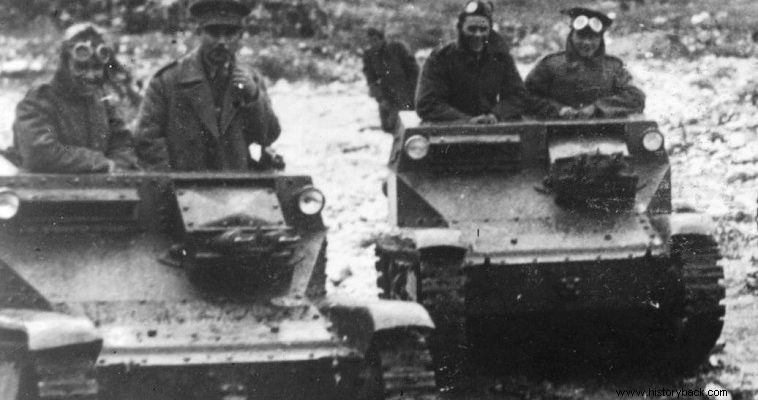
The XIX Motorized Division (M/K M) was the first motorized formation of the Hellenic Army(ES). It was formed with what was available and therefore lacking power. In other armies it would be considered something of a comedy for the one completely devoid of comparable SS units, but it could prove useful.
First of all, it should be noted that the information about this division is confusing and often conflicting. The Greek commander-in-chief Alexandros Papagos came from the Cavalry Arms. For this reason he had made sure that the only Cavalry Division of the ES became, as far as possible, an elite force. His aim was to make the division partially motorized along the lines of the French Light Cavalry Divisions and the Italian Fast-Moving Divisions (Celere).
This was not achieved and only one cavalry regiment managed to be mechanized but without any armored elements. In the interwar Greece had bought four British Vickers and Carden Lloyd tanks for evaluation. These were the only armored vehicles it had on October 28, 1940.
Gradually on the Northern Continental Front a number of Italian CV-33 and CV-35 tanks fell into the hands of the SS as booty. Of these, several became operational and thus the idea of forming a motorized force was born. Greece had ordered tanks before the start of the war, in order to form an armored regiment. But these were not delivered due to the outbreak of World War II.
The Motor Cavalry Regiment (M/K SI) had 44 Mercedes Benz W 152 4×4 vehicles, 44 Mercedes Benz LG 2500 6×6 vehicles and 75 2.5 ton FIAT trucks and a number of motorcycles.> In December 1940 a Tank Brigade was formed with 35 Italian tanks and a Tank School was established to train in the Mk III light tanks promised by the British. The British reportedly delivered 10 tanks of the type along with about 100 Universal Carriers and 185 Austin 8HP cars.
With this material it was decided, on January 15, 1941, to form the XIX M/K M the command of which was taken over by Major General Nikolaos Lioubas. The Division was also allocated the M/K SI which formed its core. Eventually the XIX M/K M reached 8,000 men. It was originally intended to have one tank regiment and two motorized infantry regiments. Due to a lack of means, however, it was decided to form three motorized regiments (191st, 192nd, 193rd). The division began to gather its various divisions in the area of Larissa - Trikala - Tyrnavos.
The Light Army of M/K SI formed the XIX Reconnaissance Group. The 1st Ili Machis, the 1st and 4th Ulamos Polyvolon and the 1st and 4th Ulamos Olmon formed the core of the 191st M/K S. The 2nd Ili Machis, the 2nd Ulamos Polyvolon and the 2nd Ulamos Olmon formed, respectively, the core of the 192nd M/K S and the 3rd Ili with the 3rd Ulamos of Olmon and the 3rd Ulamos of Polyvolos, the core of the 193rd M/K S.
The Division came to have:
Staff
– 191st M/K Regiment with the 1st Infantry Battalion (with one battle tank, 4 machine gun ulam, four 81 mm mortar ulam, Austoni 8 HP car-mounted machine gun ulam) and 2nd Tank Battalion (1st "Closed" tank ulam with 9 Mk III, 2nd Open Tank Company with 11 Carriers, also equipped with two 14mm Boys anti-tank guns and 3 3in mortars 3rd Open Tank Company and 4th Motorcyclist Company with 48 two-seater Norton 16H motorcycles and six equipped with Austin 8HP machine gun cars).
– The 192nd M/K S (same composition as the 191st, but instead of Mk III tanks Italian CV-33/35 tanks).
– The 193rd M/K S (like the 192nd)
– XIX Recognition Group (Light Mud, a Mud with 11 Carrier)
– The XIX Artillery Squadron (two 75mm guns)
– The XIX Squadron of Anti-Aircraft Artillery (two artillery pieces, one with 4 37mm guns and one with 4 20mm guns)
– 8 Italian 47 mm anti-tank guns. four 20 mm Solothurn S-18 anti-tank guns.
– Ili Diavibasas, Hygienomiki Ili, two car platoons and services.
The 19th M/K M found itself, without the 191st M/K S facing the powerful German 2nd Panzer Division which was being covered from the air by dozens of aircraft. As was understandable, the theoretically only Greek "division" had no luck against the excellently equipped German force and was swept away fighting bravely. After all, it didn't even fight united. The 191st M/K S was deployed elsewhere and the Reconnaissance Group did not enter the fight until April 8.
In the 19th, the Krousia Detachment, battalion strength + infantry company, the infantry of the 2nd SI battalion strength and an artillery squadron with two artillery regiments were subordinated. During the fight, small infantry forces were also made available to her (about three companies, two of which were disbanded by the Germans before fighting).
Some sources state that the XIX M/K M had a total of 40 light tanks and 100 Carriers . However, both the "History of Armored Cavalry" of the GES, as well as the DIS/GES volume referring to the battles in North Macedonia and Thrace, mentions 27 tanks and 77 Carriers.
The first Greek armored heroes fell in the battles against the Germans. Hilarchos D. Saribeis of the 92nd M/K S stood cheering his men on ignoring the Stukas until he was mowed down by a gust. The general Archontakis of the XIX Reconnaissance Group fought the Germans for 8 hours with a machine gun, at the head of his men stopping his advance, although wounded. He fell fighting on April 8.
